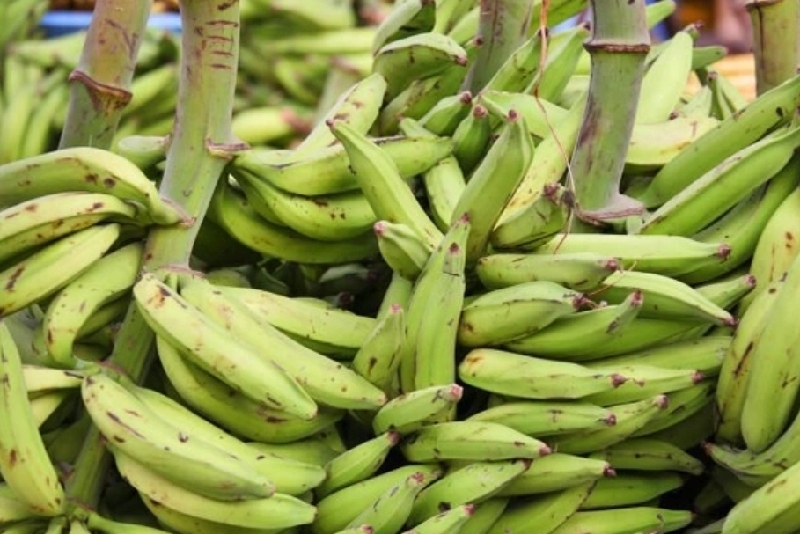Our series, African Heritage Diet as Medicine: How Black Food Can Heal the Community, explores the African Heritage Diet and highlights some of the most nutrient-dense foods found on the African continent and treasured by the diaspora.
This dietary pattern—introduced by Oldways—promotes health outcomes associated with longevity and increased vitality and features foods that are most likely to be available worldwide.
Plantains are a type of fruit that’s a staple of many diets worldwide—including the African Heritage Diet. This healthy fruit looks like a banana but is larger, starchier and less sweet than the smaller bananas that are breakfast and snack staples for many. When wandering around the produce section, you can find both green and yellow plantains.
Both of these are used in different ways to create delicious dishes like Mango, Beet & Avocado Tartare with Plantain Chips and Plantain Puff Puffs.
Here we break down the health benefits of this nutritious fruit and share its use in the African Heritage Diet and throughout the African diaspora.
What Are Plantains?
Plantains have the same shape as ordinary bananas; however, they tend to be larger. They are tropical fruit thought to have originated in Southeast Asia. They grow abundantly in tropical climates and come in a variety of hues. Yellow plantains have a sweet taste and are softer than green plantains. A peel that’s turning black is an indicator of a plantain’s ripeness and sweetness.
Since they have a starchier texture than bananas, plantains are used in many culinary applications and are great for boiling, frying, pounding and more. Among their various uses, plantains can be processed and made into flour used for baking, transformed into chips or mashed.
Across many regions of the world, including North America, Latin America, the Caribbean, Africa and parts of Southeast Asia, plantains show up as a staple in many meals and traditional dishes.
Each home cook or chef will prepare the plantain based on what they have available, cultural influence and traditional preparation techniques. Just like chicken noodle soup, each grandma, aunty or uncle, and beyond, will add their own flair.
Yellow and green plantains are great sources of potassium, fiber and vitamins A and C. They are flavorful and incredibly nutritious while supporting digestive health and more.
According to the USDA, one yellow, raw plantain (270 grams or about 9.5 ounces) contains approximately the following amounts of nutrients:
- Calories: 329
- Protein: 4 g
- Total fat: 1 g
- Saturated fat: 0 g
- Carbohydrates: 86 g
- Dietary fiber: 5 g
- Total sugar: 47 g
- Magnesium: 97 mg
- Potassium: 1,310 mg
- Vitamin C: 50 mg
- Vitamin A: 3,050 IU
While green, raw plantains contain more calories and carbohydrates than yellow plantains, their fiber content is higher, and their naturally occurring sugar content is lower.
Health Benefits of Plantains
The nutrient profile of plantains points to a number of potential health benefits.
Improve Your Digestive Health
Digestive health is important for whole-body health. The gut is one of the largest immune mediators within the human body. Plantains can help support gut health due to their fiber and starch content.
Research, as explained in a 2018 article published in Nutrients, has found that fiber from fruits is an essential part of supporting digestive health and may be influential in reducing the risk of developing IBS, IBD and diverticular disease.
Eating sufficient amounts of fiber supports regular bowel movements and increases the diversity of colonic bacteria in your gastrointestinal tract. According to 2021 data published in Advances in Nutrition, diverse bacteria in the gut support endocrine health, immune health and brain health.
Protect Your Heart Health
Cardiovascular diseases are the leading causes of mortality worldwide, responsible for over 32% of all deaths, per the World Health Organization. Many eating patterns have been studied in relation to cardiovascular disease risk reduction, including the African Heritage Diet. Plantains are supportive of cardiovascular health because of their fiber and potassium content.
According to 2019 research, dietary fiber has been shown to be involved in reducing LDL cholesterol and blood pressure, thus reducing the risk of cardiovascular disease. And potassium helps improve your blood pressure by acting as a vasodilator—reducing the tension in your blood vessel walls.
Support Your Immune Health
Plantains are a good source of antioxidants, including vitamins C and A. Antioxidants are compounds that help reduce free radical damage and oxidative stress and may lower the risk of diseases such as cancer. Vitamins A and C are two of the top nutrients to support your immune system and fight disease.
How Plantains Are Eaten throughout the African Diaspora
Africa
West and Central Africa are home to multiple species of cultivated plantains. Each region within the continent has developed growing and harvesting techniques in relation to the climate and topography. In addition, preparation techniques and flavor profiles vary.
For example, in parts of East Africa, including Uganda and Kenya, green plantains are boiled and mashed into a dish called matoke that is sometimes spiced with ginger, cardamom and black pepper, as well as cumin, coriander, tomatoes and hot peppers.
In Ghana, kelewele is a fried spicy dish made with sweet plantains, sometimes served alone, or with rice or animal proteins.
North America
Plantains are not historically a staple part of African American foodways. During the middle passage, enslaved Africans brought plantain seeds to grow, but plantains weren’t cultivated since they are tropical fruit. More recently, plantains have grown in popularity due to their health benefits and increased accessibility of tropical fruit in the United States.
Additionally, many people in the U.S. with roots in Latin America, the Caribbean and Africa may recognize plantains as heritage foods and love to incorporate them into their dishes.
Latin America & the Caribbean
Plantains made their way to Latin America and the islands of the Caribbean during the middle passage as well as during colonization. These regions’ proximity to the equator and fertile land is perfect for the year-round growth of plantains.
In Trinidad and Tobago, as well as Haiti, the Dominican Republic and Puerto Rico, plantains are enjoyed fried and usually seasoned with salt and garlic.
In Trinidad and Tobago, lunch or dinner may be served with a side of boiled provisions (root vegetables and fruits, including plantains). Mofongo, a dish often eaten in Puerto Rico and the Dominican Republic, consists of boiled or roasted, seasoned and pounded plantains. Mangu, green mashed plantains with olive oil or butter, graces many plates in the Dominican Republic.
The Bottom Line
Plantains are a tropical fruit enjoyed throughout the African diaspora and in other traditional cuisines. They are a nutritious staple that can be enjoyed in many culinary applications. Add plantains to your diet to reap this fruit’s health benefits, from supporting your immune health to helping reduce LDL cholesterol.
Ashantibiz




